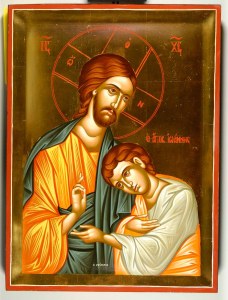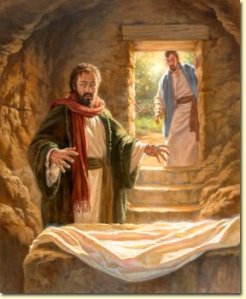The Gospel of John is the Gospel that is read on Easter in Church. The Gospel contains a reference to a character “The Beloved Disciple” or “The one whom Jesus loved.” This person is traditionally associated with John, whom is traditionally believed to be the writer of the Gospel. Other candidates have been Mary Magdalene, James the Brother of the Lord, Lazarus, or even Mary or Martha (Lazarus’ sisters).
Today, however, while listening again to the story of Jesus greeting Mary Magdalene and her telling the disciples and Peter and the Beloved Disciple rushing to the tomb, it struck me for the first time: “What if I am the Beloved Disciple?” By this, I of course mean: “What if the Beloved Disciple is supposed to be the reader or hearer of the Gospel?”
Movies and books are told from a frame of reference or a point of view. The original Star Wars, for instance (now known as Episode IV), is told from the frame of reference of the two Droids C3PO and R2D2. The audience is outside the story, but it is primarily through these two characters that the audience enters into the story. What if “The Beloved Disciple” is a similar literary device? What if, whenever we come across the Beloved Disciple, we are supposed to read ourselves into the narrative? To put it another way: “What if the Beloved Disciple is the personification of the believers in Jesus Christ?” What if This Disciple is the Church, not in its organization, or institutional structure, or polity, but as “The People” united together in one faith?
The Beloved Disciple does not appear in the Gospel until Jesus at supper with his Apostles/Disciples (Apostle is never used for the Disciples in John’s Gospel and the only Apostle �" or one who is sent out with authority is Christ himself). The term or person appears directly in the narrative about six times:
- It is this disciple who, while reclining beside Jesus at the Last Supper, asks Jesus, after being requested by Peter to do so, who it is that will betray him.[Jn 13:23-25]
- Later at the crucifixion, Jesus tells his mother, “Woman, here is your son”, and to the Beloved Disciple he says, “Here is your mother.”[Jn 19:26-27]
- When Mary Magdalene discovers the empty tomb, she runs to tell the Beloved Disciple and Peter. The two men rush to the empty tomb and the Beloved Disciple is the first to reach the empty tomb. However, Peter is the first to enter.[Jn 20:1-10]
- In John 21, the last chapter of the Gospel of John, the Beloved Disciple is one of seven fishermen involved in the miraculous catch of 153 fish.[Jn 21:1-25] [5]
- Also in the book’s final chapter, after Jesus hints to Peter how Peter will die, Peter sees the Beloved Disciple following them and asks, “What about him?” Jesus answers, “If I want him to remain until I come, what is that to you? You follow Me!”[John 21:20-23]
- Again in the gospel’s last chapter, it states that the very book itself is based on the written testimony of the disciple whom Jesus loved.
So how does the hearing or reading of the story change if I place myself (or you place yourself; or the Church places itself) in the role of The Beloved Disciple? To me, is suddenly makes the Gospel very Catholic, perhaps even more Roman Catholic than I would like to admit as an Old Catholic.
Peter is present and has a certain authority. The Beloved Disciple seeks clarification on the insistence of Peter. Peter can represent Apostolic Authority, or can (as he often does in Roman Catholicism) represent the Bishop of Rome. Yet, it is not simply Peter dictating to the Disciple. The Beloved Disciple is acting on Peter’s suggestion, but Peter only gets clarification when the Beloved Disciple seeks clarification on Peter’s behalf. Therefore, there is a partnership between this Beloved Disciple and the Apostolic Authority of the Church.
There is also an element of respect regarding Apostolic Authority in that the Beloved Disciple outruns Peter to the tomb, but stops and waits for Peter to enter first. The people in the Church may run ahead of where the leadership of the Church may be. The people may get there first before the Apostles, the Bishops, the Popes; yet, even though they may arrive and peer into the new future, they are to wait for the Apostles to examine and take the lead. Again, I see this as a partnership more than as a simple hierarchy: The people drag the Church leadership with them as they rush toward their collective futures; yet, the leadership, once it catches up, takes the lead and sets the parameters for the new understanding. Sometimes it is a long wait for Peter to catch up to us when we run, but perhaps it is better to wait and make sure we all get it right, or come to an understanding that serves all, rather than quickly developing a doctrine or a teaching that is difficult to live with later �" and since doctrine is unchangeable, it is best to take time to get it right, rather than to paint ourselves into a corner of error.
The people of the Church are also given Mary as their Mother. Catholicism has always accepted Mary, the Mother of Jesus, as the Mother of the Church. There are varying degrees of this, but the Blessed Virgin is also the Blessed Mother to Catholics, whether they are Roman Catholics, Eastern Orthodox Catholics, or Old Catholics. This is not to say that there is not the occasional error that develops regarding Mary, but there is a sense that the Blessed Mother is offered as a gift to the Church and the people of the Church are offered as a gift to the Blessed Mother.
It is also the people working with the Apostolic Leadership that catches a large number of fish, and since they have become “fishers of people,” perhaps the fish are not fish, but a metaphor or allegory for converts to the faith. Also, if the Beloved Disciple is the collective faithful, then Jesus tells Peter that even though he may pass away or become old and difficult to relate to, there will always be faithful �" the Church will always continue in some form, even if it moves beyond Peter himself. The faithful are still Apostolic even when the Church symbolized by Peter is old, decayed, crippled, and out of date.
Finally, if the Beloved Disciple is me and you, then the faith is passed along by me and you. The Beloved Disciple is the one who relays the stories and expresses the faith of who Jesus is. The Beloved Disciple is the one who is the witness and who testifies. Therefore, it is how you and I witness and testify that presents Jesus to the world and makes him both visible and known. Therefore, Jesus must be visible and known by us if the world is to see and know him. Jesus must be real to us if he is to be real to the world. We are the ones who share Jesus with the world. This sharing is done by us showing the world who Jesus is �" not telling, not only with words or preaching. We show who Jesus is by living how Jesus said to live. We follow his commandments because that is how we show the world we love Christ because Christ tells us that if we love him, then we will keep his commandments. If we do not keep them, then not only do we not love Jesus, but we have nothing to offer the world, and we are lying to them and to ourselves.
So, imagine, just imagine: YOU are the Beloved Disciple! YOU are the one whom Jesus loves! What are YOU going to do about it?



 Flag Writing
Flag Writing